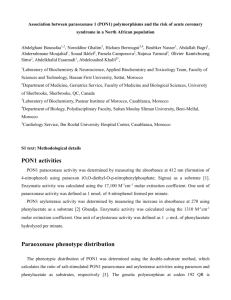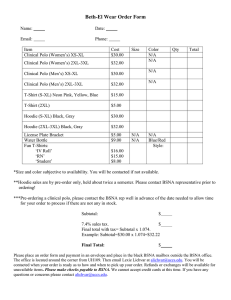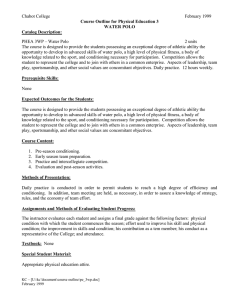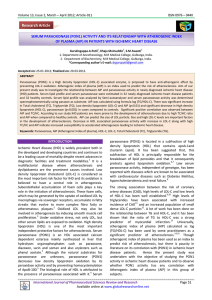Document 13310039
advertisement
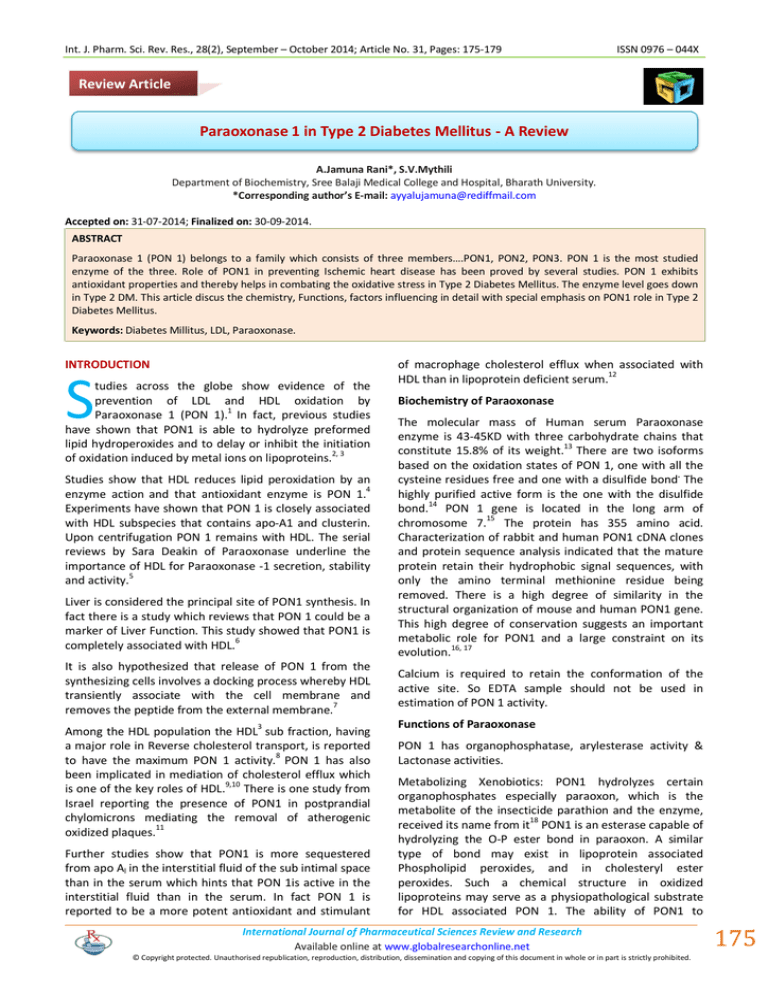
Int. J. Pharm. Sci. Rev. Res., 28(2), September – October 2014; Article No. 31, Pages: 175-179 ISSN 0976 – 044X Review Article Paraoxonase 1 in Type 2 Diabetes Mellitus - A Review A.Jamuna Rani*, S.V.Mythili Department of Biochemistry, Sree Balaji Medical College and Hospital, Bharath University. *Corresponding author’s E-mail: ayyalujamuna@rediffmail.com Accepted on: 31-07-2014; Finalized on: 30-09-2014. ABSTRACT Paraoxonase 1 (PON 1) belongs to a family which consists of three members….PON1, PON2, PON3. PON 1 is the most studied enzyme of the three. Role of PON1 in preventing Ischemic heart disease has been proved by several studies. PON 1 exhibits antioxidant properties and thereby helps in combating the oxidative stress in Type 2 Diabetes Mellitus. The enzyme level goes down in Type 2 DM. This article discus the chemistry, Functions, factors influencing in detail with special emphasis on PON1 role in Type 2 Diabetes Mellitus. Keywords: Diabetes Millitus, LDL, Paraoxonase. INTRODUCTION S tudies across the globe show evidence of the prevention of LDL and HDL oxidation by Paraoxonase 1 (PON 1).1 In fact, previous studies have shown that PON1 is able to hydrolyze preformed lipid hydroperoxides and to delay or inhibit the initiation of oxidation induced by metal ions on lipoproteins.2, 3 Studies show that HDL reduces lipid peroxidation by an enzyme action and that antioxidant enzyme is PON 1.4 Experiments have shown that PON 1 is closely associated with HDL subspecies that contains apo-A1 and clusterin. Upon centrifugation PON 1 remains with HDL. The serial reviews by Sara Deakin of Paraoxonase underline the importance of HDL for Paraoxonase -1 secretion, stability and activity.5 Liver is considered the principal site of PON1 synthesis. In fact there is a study which reviews that PON 1 could be a marker of Liver Function. This study showed that PON1 is completely associated with HDL.6 It is also hypothesized that release of PON 1 from the synthesizing cells involves a docking process whereby HDL transiently associate with the cell membrane and removes the peptide from the external membrane.7 3 Among the HDL population the HDL sub fraction, having a major role in Reverse cholesterol transport, is reported 8 to have the maximum PON 1 activity. PON 1 has also been implicated in mediation of cholesterol efflux which 9,10 is one of the key roles of HDL. There is one study from Israel reporting the presence of PON1 in postprandial chylomicrons mediating the removal of atherogenic oxidized plaques.11 Further studies show that PON1 is more sequestered from apo Al in the interstitial fluid of the sub intimal space than in the serum which hints that PON 1is active in the interstitial fluid than in the serum. In fact PON 1 is reported to be a more potent antioxidant and stimulant of macrophage cholesterol efflux when associated with 12 HDL than in lipoprotein deficient serum. Biochemistry of Paraoxonase The molecular mass of Human serum Paraoxonase enzyme is 43-45KD with three carbohydrate chains that constitute 15.8% of its weight.13 There are two isoforms based on the oxidation states of PON 1, one with all the cysteine residues free and one with a disulfide bond. The highly purified active form is the one with the disulfide bond.14 PON 1 gene is located in the long arm of chromosome 7.15 The protein has 355 amino acid. Characterization of rabbit and human PON1 cDNA clones and protein sequence analysis indicated that the mature protein retain their hydrophobic signal sequences, with only the amino terminal methionine residue being removed. There is a high degree of similarity in the structural organization of mouse and human PON1 gene. This high degree of conservation suggests an important metabolic role for PON1 and a large constraint on its evolution.16, 17 Calcium is required to retain the conformation of the active site. So EDTA sample should not be used in estimation of PON 1 activity. Functions of Paraoxonase PON 1 has organophosphatase, arylesterase activity & Lactonase activities. Metabolizing Xenobiotics: PON1 hydrolyzes certain organophosphates especially paraoxon, which is the metabolite of the insecticide parathion and the enzyme, received its name from it18 PON1 is an esterase capable of hydrolyzing the O-P ester bond in paraoxon. A similar type of bond may exist in lipoprotein associated Phospholipid peroxides, and in cholesteryl ester peroxides. Such a chemical structure in oxidized lipoproteins may serve as a physiopathological substrate for HDL associated PON 1. The ability of PON1 to International Journal of Pharmaceutical Sciences Review and Research Available online at www.globalresearchonline.net © Copyright protected. Unauthorised republication, reproduction, distribution, dissemination and copying of this document in whole or in part is strictly prohibited. 175 © Copyright pro Int. J. Pharm. Sci. Rev. Res., 28(2), September – October 2014; Article No. 31, Pages: 175-179 hydrolyze toxic peroxides in oxidized lipids of both LDL and HDL can thus reverse potential atherogenic effects.PON1 is reported to efficiently act on not only the lipoprotein – associated peroxides, but also Hydrogen 19 peroxide. Mackness et al. showed that human PON1 could inhibit LDL oxidation in vitro, (prevent formation of oxidized LDL) and protect phospholipids in HDL from oxidation by inactivating LDL-derived oxidized phospholipids. These actions suggest that PON1 could prevent the accumulation of lipoperoxides in LDL and has a protective role against cardiovascular diseases and atherosclerosis. Hence low PON1 activity could be a detector of Coronary artery diseases. There are studies supporting that PON 1 activity is a better predictor of atherosclerosis risk than 20-23 are genetic polymorphisms assays alone. PON 1 has unique antioxidant properties. The effect of HDL associated PON1 in decreasing the LDL lipid peroxidation is maintained for longer than that of antioxidant vitamins and could therefore be more protective.24 PON 1 has a role in metabolism of pharmaceutical drugs also.25 There are a wide range of serum concentrations and activities of PON1 in humans. It should be noted that in a given population, plasma PON1 activity can vary up to 40 fold, and PON protein levels up to 13 fold are also present within a single PON 1 192 genotype. It has been suggested that subjects with low PON1 activity may have a greater risk of developing diseases in which oxidative damage and lipid peroxidation are involved, compared to subjects with high PON1 activity.26 Factors Influencing Paraoxonase Activity Age PON 1 protection effect towards LDL peroxidation has shown to be decreasing with age. This decline in PON1 activity could be related to development of oxidative stress conditions with aging. This decrease in activity is shown to be due also to diminished SH content in PON 1.27,28 Gender A study from the National University of Singapore reports that the genetic heterogeneity in humans would obscure any gender effects on PON1 activity. Very few studies prove a marginal increase in PON 1 activity among females. 29 Alcohol Serum PON 1 activity was significantly decreased in alcoholic patients when compared with controls as per Judith Marsillach et al.30 Smoking Smoking is also implicated in reduced PON1 activity due to modifications of the Free Thiol groups in the enzymes. ISSN 0976 – 044X On quitting smoking it takes two –three months for the enzyme to get back to its normal activity.31-33 Diet After intake of a fatty meal, by healthy men serum PON1 activity decreased by 27% for up to 8 hours but returned to normal values by 12 hours. Replacement of dietary saturated fat with trans fat was found to reduce PON1 activity by 6%.34,35 PON 1 undergoes inactivation by oxidative stress and its activity is preserved by 36 dietaryantioxidants. A Cholesterol rich diet decreases serum PON1 activity in wild type rabbits.37 On the contrary consumption of pomegranate juice38,39 as well as 40 Vitamin C and E , increased serum PON1 levels. Reduced serum PON1 Activity was observed in post prandial state after consumption of degraded cooking oil.41, 42 Drugs Oral Hypoglycemic drugs are found to have antioxidant effect. This could be one of the confounding factors in estimation of Total antioxidant status. Gemfibrozil is believed to have beneficial effect on PON1 activity.43 Paraoxonase 1 in Diabetes Diabetes is associated with oxidative damage. The increased serum oxidative stress in DM could be the result of glycation and glycol-oxidation of LDL by glucose.44 The higher levels of lipid peroxidation products in plasma of diabetic patients could be related to a higher susceptibility of their plasma lipoproteins to oxidation and/or to a decrease of plasma antioxidant defenses. 45,46 Paraoxonase, an antioxidant enzyme is being used up in balancing the oxidative stress in diabetes mellitus and hence a decrease of PON1 activity has been observed in diabetic patients .A study from Paris reports that PON1 activity decreased even in early stages of Diabetes Mellitus47 Likewise a study in Pakistan also reports decreased PON1 activity in diabetics.48 Further, in a study among North West Indian Punjabi diabetics also there was decreased PON 1 activity in comparison to healthy population.49 Glycation of PON1 impairs its enzyme activity.50 Hedrick and coworkers have reported in vitro, direct glycation of purified Paraoxonase enzyme protein by incubation with 25mmol/l glucose caused a 40% decrease in enzymatic activity and they also documented a similar decrease in Type 2 Diabetic patients. The Glycated PON 1 could not inhibit monocyte adhesion to human aortic endothelial cells in vitro. They have also reported Coronary artery disease in these Type 2 diabetics compared to non diabetics. Moreover, previous studies have shown the susceptibility of HDL to atherogenic modifications induced in vitro, such as glycation and homocysteinylation.51 Reduced PON1 activity in type 2 diabetic patients was found to be associated with a significant increase in the risk of cardiovascular disease (CVD) which leads to the conclusion that PON1 activity 52,53 could be a predictor of CVD in type 2 diabetes. Ikeda International Journal of Pharmaceutical Sciences Review and Research Available online at www.globalresearchonline.net © Copyright protected. Unauthorised republication, reproduction, distribution, dissemination and copying of this document in whole or in part is strictly prohibited. 176 © Copyright pro Int. J. Pharm. Sci. Rev. Res., 28(2), September – October 2014; Article No. 31, Pages: 175-179 et al from Japan have shown low PON 1 activity in diabetes patients with macro vascular complications in comparison with those without any complication.54 The decrease of PON1 activity in diabetic patients and the lowered HDL protective action against membrane peroxidation could contribute to acceleration of arteriosclerosis in type 1 & 2 diabetes mellitus.55 Several mechanisms have been postulated for this decrease in Activity: According to the study of Mira 55 Rosenblat et al this is due to the dissociation of PON1 from HDL as a free, unstable PON1. Another study gives an explanation at the secretory level. It appears that large sized HDL complexes favor PON1 secretion. In clinical syndromes like Diabetes the HDL size tends to diminish.56 Further the fact that free cholesterol addition to reconstituted HDL influences its capacity to promote PON1 release may also have clinical implications.55 Un esterified cholesterol partitions into the outer lipid layer in native lipoprotein complexes, and it can adversely affect the lipoprotein function if present in elevated concentrations. Pathological changes due to un esterified cholesterol have been reported for diabetic patients. These factors together set the stage for the progression of associated complications of Diabetes Mellitus. Decrease in Paraoxonase activity creates susceptibility to diabetes complications as reported by a study from Hungary.56 In a study at South Karnataka, Renuka Suvarna et al reports that the levels of HDL-C and PON 1 activity are decreased significantly in diabetic patients with complications in comparison to diabetics without complications.57 Both Paraoxonase and arylesterase activities of PON1 were lower in diabetic foot patients from a Romanian study compared to healthy control subjects58 Low Paraoxonase activity in type 2 diabetes mellitus complicated by retinopathy have also been reported.59 Bharti Mackness et al assayed PON1 activity as well as PON1concentration in controls and type 2 diabetic patients and found that though the activity of the enzyme 60 varied, the concentration remained the same. Further the same groups have reported that Gene polymorphism had no relation to decrease of PON 1 activity among a South Wales population.61 The PON1 concentration was not different between the patients with diabetes and the controls, but their specific activity assayed showed difference as reported in a study from Japan.62 Another study from Prague revealed that PON1 activity was decreased in type 1 and type 2 diabetic patients compared to non-diabetic control subjects although the concentration of serum PON 1 were not 63 significantly different between the 2 groups. Reports of a study from a South Chennai population also prove that PON1 decreases with progression of Type 2 Diabetes 64 mellitus. ISSN 0976 – 044X CONCLUSION Paraoxonase 1 proves to be a miracle enzyme with all its functions. Natural methods to increase the levels of this antioxidant surely ought to be beneficial for maintaining the quality of lifestyle of Diabetic subjects. REFERENCES 1. Karabina SA, Lehner AN, Franke E, Parthasarathy S-Oxidative inactivation of paraoxonase—implications in diabetes mellitus and atherosclerosis, Biochem Biophys Acta, 1725, 2005, 213-221. 2. Bulent Sozmen, Yasemin Delen, Ferhan K, Girgin, Catalase and paraoxonase in hypertensive type 2 Diabetic Mellitus, Correlation with glycemic control, Clinical biochemistry, 32, 1999, 423-427. 3. Michael Aviram, Mira Rosenblat, Scott Billecke, John Erogul, Human PON1 is inactivated by oxidized LDL and preserved by a antioxidants, Free radical biology medicine, 26, 1999, 892-904. 4. Michal Harel, Amir Aharoni, Leonid Gaidukov- Structure and evolution of the serum Paraoxonase family of detoxifying and anti –atherosclerotic enzymes, Nature structural & Molecular Biology, 11(5), 2004, 412-419. 5. Sara Deakin, Ilia Leviev, Monica Gomaraschi- Enzymatically active Paraoxonase 1 is located at the external membrane of Producing cells and released by high affinity, saturable, desorption Mechanism, The journal of Biological chemistry, 277(6), 2002, 4301-4308. 6. Jordi Camps, Judit Marsillach, Jorge Joven- Measurement of serum paraoxonase-1 activity in the evaluation of liver function, World J Gastroenterol, 28(15), 2009, 16. 7. Richard W, James and Sara P Deakin, The importance of High Density Lipoproteins for Paraoxonase -1 secretion, stability and activity, Free Radical Biology and Medicine, 37(12), 1994, 19861994. 8. Christoph Bergmeir, Rudiger Siekmeir, Werner Gross, Distribution of Paraoxonase activity in HDL Fractions, Clinical Chemistry, 50:12, 2004, 2309-2315. 9. Lund-katz. S, Liu LJ, Thuahnai ST, Philips MC, High density lipoprotein structure, Front.Biosci., 8, 2003, 1044-1054. 10. Rosenblat M, Vaya J, Shih DM, Aviram M, Paraoxonase 1 (PON1) enhances HDL-mediated macrophage cholesterol efflux via the ABCAI transporter in association with increased HDL binding to the cells: A possible role for Lysophospahtidyl choline, Atheroscerosis, 179, 2005, 69-77. 11. Fuhrman B, Volkova N, Aviram M, Paraoxonase (PON1) is present in post prandial chylomicrons, Atherosclerosis, 180, 2005, 55-61. 12. Mira Rosenblat, Rachel Karry, Michael Aviram, Paraoxonase 1 ( PON 1) is a more potent antioxidant and stimulant of macrophage cholesterol efflux when present in HDL than in lipoprotein deficient serum: Relevance to diabetes, Atherosclerosis, 187: 74, 2006, e1-74.e10. 13. PN Mackness, B Mackness MI, The hunt for nutritional and pharmacological modulators of paraoxonase, Arterioscler Thromb Vasc Biol, 22, 2002, 1248-1250. 14. Abbot CA, Mackness MI, Kumar S, Boultan AJ - Serum paraoxonase activity, concentration, and phenotype distribution in diabetes mellitus and its relationship to serum lipids and lipoproteins, Arterioscler Thromb Vasc Biol., 15, 1995, 1812-1818. 15. Gan KN, Smolen A, Eckerson H, Wand La Du BN, Purification of human serum Paraoxonase / Arylesterase, Drug.Metab.Dispos., 19, 1991, 100-106. 16. Aviram M, Rosenblat M, Paraoxonases 1, 2, and 3, oxidative stress, and macrophage foam cell formation during atherosclerosis development, Free Radical Biol. Med., 37, 2004, 1304–1316. International Journal of Pharmaceutical Sciences Review and Research Available online at www.globalresearchonline.net © Copyright protected. Unauthorised republication, reproduction, distribution, dissemination and copying of this document in whole or in part is strictly prohibited. 177 © Copyright pro Int. J. Pharm. Sci. Rev. Res., 28(2), September – October 2014; Article No. 31, Pages: 175-179 ISSN 0976 – 044X 17. Michael Aviram, Mira Rosenblat, Charles L, Bisgaier - Paraoxonase inhibits High density Lipoprotein Oxidation and Preserves its function-A Possible Peroxidative Role for Paraoxonase, J.Clin.Invest., 101(8), 1998, 1581-1590 40 in intro. 35. Michael Aviram, Mira Rosenblat, Scott Billecke, John Erogul, Human serum Paraoxonase (PON 1) is inactivated by oxidized low density lipoprotein and preserved by antioxidants, 26(7-8), 1999, 892-904. 18. Mackness MI, Arrol S, Abott CA, Durrington PN, Protection of low density lipoprotein against oxidative modification by high density lipoprotein associated Paraoxonase, Atherosclerosis, 104, 1993, 129-135. 36. Mackness M, Boullier A, Hennuyer N, Paraoxonase activity is reduced by pro-atherosclerotic diet in rabbits, Biochem Biophys Res Commun, 269, 2000, 232-236. 37. 19. Jaouad L, Milochevitcg C, Khalil A, PON 1 paraoxonase activity is reduced during HDL oxidation and is an indicator of HDL antioxidant capacity, Free Radic Res., 37, 2003, 77-83. 20. Browne RW, Koury ST, Marion S, Wilding G- Accuracy and biological variation of human serum Paraoxonase 1 activity and polymorphism (Q192R) by kinetic enzyme assay, Clinical Chemistry, 53.2, 2007, 310-317. Wasseem Rock, Mira Rosenblat, Rachel Miller Lotan, Andrew P, Levy, Consumption of Wonderful Variety Pomegranate Juice and Extract by Diabetic Patients Increases Paraoxonase 1 Association with High-Density Lipoprotein and Stimulates Its Catalytic Activities, J. Agric. Food Chem., 56, 2008, 8704–8713. 38. Richter RJ, Fulong CE, Determination of Paraoxonase (PON1) status requires more than genotyping, Pharmacogenetics, 9, 1999, 745753. Aviram M, Dornfeld L, Rosenblat M, Pomegranate juice consumption reduces oxidative stress, atherogenic modifications to LDL, and platelet aggregation: Studies in humans and in atherosclerotic apolipoprotein E deficient mice, Am JClin Nutr., 71, 2000, 1062-1076. 39. Bharti Mackness, Paul N.Durringtn, Bashir Abuashia, Andrew JM, Boulton -Low PON1 activity in type II Diabetes Mellitus complicated by retinopathy, Clinical Science, 98, 2000, 355-363. Jarvik GP, Tsai NT, McKinstry LA, Wani R, Vitamin C and E intake is associated with increased Paraoxonase activity, Arterioscler Thromb Vasc Biol., 22, 2001, 1329-1333. 40. Sutherland WHF, Walker RJ, de Jong SA, van Rij AM, Philips V, Reduced postprandial serum Paraoxonase activity after a meal rich in used cooking fat, Arterioscler Thromb Vasc Biol., 19, 1999, 13401347. 41. Durrington PN, MacknessB, Mackness MI, The hunt for nutritional and pharmacological modulators of paraoxonase, Arterioscler Thromb Vasc Biol., 22, 2002, 1248-1250. 42. Z Balogh, I Series, M Harangi, P Kovacs, Gemfibrozil increases Paraoxonase activity in type 2 Diabetic patients, A new hypothesis of the beneficial action of Fibrates, Diabetes Metab(Paris), 27, 2001, 604-610. 43. Ceriello A, Oxidative stress and glycemic regulation, Metabolism, 49(2), 2000, 27-29. 44. Baynes JW, Role of oxidative stress in development of complications in diabetes, Diabetes, 40, 1991, 405-412. 45. Epidemiology of type 2 diabetes: Indian scenario Mohan V. Sandeep S, Madras Diabetes Research Foundation & Dr Mohan's Diabetes Specialities Centre, Chennai, India, Indian J Med Res, 125, 2007, 217-230. 46. Letellier C, MP Durou, AM Jouanolle, JY Le Gall, Serum Paraoxonase activity and Paraoxonase gene polymorphism in type 2 Diabetic patients with or without vascular complications, Diabetes Metab., 28(4), 2002, 297-304. 47. Nidhi Gupta, BK Binukumar, Surjit Singh, Aditya Sunkaria, Serum paraoxonase-1 (PON1) activities (PONase/AREase) and polymorphisms in patients with type 2 diabetes mellitus in a North-West Indian population Gene, 487, 2011, 88–95. 48. Zehra Hashim, Shamshad Zarina Assessment of paraxonase activity and lipid peroxidation levels in diabetic and senile subjects suffering from cataract, Clinical Biochemistry, 40, 2007, 705-709. 49. Hedrick CC, Thorpe SR, Fu M-X, Harper CM, Glycation impairs high density lipoprotein function, Diabetologia, 43, 2000, 312-320. 50. Surjit Singh, S Venketesh, JS Verma, Minni Verma, Paraoxonase (PON1) activity in north west Indian Punjabis with coronary artery disease & type 2 diabetes mellitus, Indian J Med Res., 125, 2007, 783-787. 51. Ikeda Y, Suehiro T, Inoue M, Nakauchi Y, Serum paraoxonase activity and its relationship to diabetic complications in patients with non-insulin dependent diabetes mellitus, Metabolism, 47, 1998, 598-602. 52. M Flekac, J Skrha, K Zidkova, Z Lacinova, Paraoxonase 1 Gene Polymorphism and Enzyme activities in Diabetes Mellitus, Physiol.Res, 57, 2008, 717-726. 21. 22. 23. Bharti Mackness, Paul N.Durrington, Micahel I, Mackness- Human serum paraoxonase, Gen Pharmacology, 31(3), 1998, 329-336. 24. Lucio G.Costa, Toby B.Cole, Gail P.Jarvik, Clement E.Furlong, Functional Genomics of the Paraoxonase (PON1) polymorphisms: Effects on Pesticide sensitivity, cardiovascular disease, and Drug Metabolism, Annu.Rev.Med, 54, 2003, 371-392. 25. M Prakash, NM Phani, R Kavya, M Supriya, Paraoxonase its antiatherogenic role in chronic renal failure, 20(1), 2010, 9-14. 26. Seres I, Paragh G, Deschene E, Fulop T, Study of factors influencing the decreased HDL associated PON1 activity with aging, Exp Gerontol, 39, 2004, 59-66. 27. Leila Jaouad, Chantal de Guise, Hicham Berrougu, Martin cloutier, Age related decrease in high density lipoprotein antioxidant activity is due to an alteration in the PON1’s free sulfhydryl groups, Atherosclerosis, 185(1), 2006, 191-200. 28. Azhar Bin Ali, Qian Zhang, Yew Koon Lim, Fang Dong, Expression of Major HDL-associated antioxidant PON1 is gender dependant and regulated during inflammation, Free Radical Biology & Medicine, 34(7), 2003, 824-829. 29. Judit Marsillach, Natalia Ferre, Maria C, Vila and Lligona Anna, Serum Paraoxonase-1 in chronic alcoholic: Relationship with Liver disease, Clinical Biochemistry, 40(9-10), 2007, 645-650. 30. Eisuke Nishio, Yasuhiro Watnabe, Cigarette smoke extracts inhibits Paraoxonase activity by modification of the Enzyme’s free thiols, Biochemical and Biophysical research communications, 236, 1997, 289-293. 31. M Boemi, C Sirolla, R Testa, Cenerelli S, Smoking is associated with reduced serum level of the antioxidant enzyme, paraoxonase in Type II Diabetes Mellitus, Diabetes Metabolism, 21, 2004, 423-427. 32. Richard W. James, Ilia Leviev, Alberto Righetti, Smoking is associated with reduced Serum Paraoxonase activity and concentration in patients with coronary artery disease, Circulation, 101, 2000, 2252-2257. 33. 34. Zorica Rasic Milutinovic, Tamara Popovic, Gordana Perunicic Pekovic, Aleksandra Arsic, Lower Serum Paraoxonase-1 Activity Is Related to Linoleicand Docosahexanoic Fatty Acids in Type 2 Diabetic Patients, Archives of Medical Research, 43, 2012, 75-82. De Roos NM, Schouten EG, Scheek LM, Van Tol, A Replacement of dietary saturated fat with trans fat reduces serum Paraoxonase activity in healthy men and women, Metabolism, 51, 2002, 15341537. International Journal of Pharmaceutical Sciences Review and Research Available online at www.globalresearchonline.net © Copyright protected. Unauthorised republication, reproduction, distribution, dissemination and copying of this document in whole or in part is strictly prohibited. 178 © Copyright pro Int. J. Pharm. Sci. Rev. Res., 28(2), September – October 2014; Article No. 31, Pages: 175-179 ISSN 0976 – 044X 53. Soukharev S, Hammond DJ, A fluorogenic substrate for detection of organophosphatase activity, Anal Biochem., 327(1), 2004, 140148. 59. Bharti Mackness, Paul Durrington, Patrick McElduff, John, Low Paraoxonase activity predicts coronary events in the Caerphilly Prospective study, Circulation, 107, 2003, 2775-2779. 54. Mira Rosenblat, Rachel Karry, Michael Aviram, Paraoxonase 1 (PON1) is a more potent antioxidant and stimulant of macrophage cholesterol efflux, when present in HDL than in lipoprotein – deficient serum: Relevance to diabetes, Atherosclerosis, 187, 2006, 74.el-74e10. 60. Jarvik GP, Hatsukami TS, Carlson C, Richter RJ, Paraoxonase activity, but not haplotype utilizing the linkage disequilibrium structure, predicts vascular disease, Arterioscler Thromb Vasc Biol., 23, 2003, 1465-1471. 61. 55. Laura S. Rozek, Thomas S. Hatsukami, Rebecca J, Richter and Jane Ranchalis -The correlation of paraoxonase (PON1) activity with lipid and lipoprotein levels differs with vascular disease status, Journal of Lipid research, 46(9), 2005, 1888–1895. Mari Inoue, Tadashi Suehiro, Toshihiro Nakamura, Yukio Ikeda, Serum arylesterase /Diazoxone Activity and genetic polymorphisms in patients with type 2 Diabetes, Metabolism, 49(11), 2000, 1400-1405. 62. 56. T Kalmar, I Seres, Z Balogh, M Kaplar, Correlation between the activities of lipoprotein lipase and paraoxonase in type 2 Diabetes Mellitus, Diabetes Metabolism, 31, 2005, 574-580. 57. Renuka Suvarna, Soumya S Rao, Chitralekha Joshi, Vivekananda Kedage, Paraoxonase activity in Type 2 Diabetes Mellitus patients with and without complications, Journal of clinical and diagnostic research, 5(1), 2011, 63-65. R.Scott Rector, Shana O, Warner, Ying Liu, Pamels and S.Hinton, Excercice and diet induced weight loss improves measures of oxidative stress and insulin sensitivity in adults with characteristics of the metabolic syndrome, Am J Physiol Endocrinol Metab, 293, 2007, E500-E506. 63. Koenig RJ, Peterson CM, Jones RL, Saudek, Corelation of Glucose regulation and Haemoglobin A1c in diabetes mellitus, N Eng J Med., 295, 1976, 417-420. 64. Jamuna Rani A, Mythili SV, Shunmugam Nagarajan, Study on Paraoxonase 1in Type 2 Diabetes Mellitus, Indian J Physiol Pharmacol, 58(1), 2014, 13–16. 58. Romania Daniela Lixandru, Maria Mohora, Anca Coman, Irina Stoian Diet and Paraoxonase 1 Enzymatic activity in diabetic foot patients from Romani and Belgium: Favorable Association of High Flavanoid Dietary intake with arylesterase activity, Ann Nutr Metab., 56, 2010, 294-301. Source of Support: Nil, Conflict of Interest: None. International Journal of Pharmaceutical Sciences Review and Research Available online at www.globalresearchonline.net © Copyright protected. Unauthorised republication, reproduction, distribution, dissemination and copying of this document in whole or in part is strictly prohibited. 179 © Copyright pro
